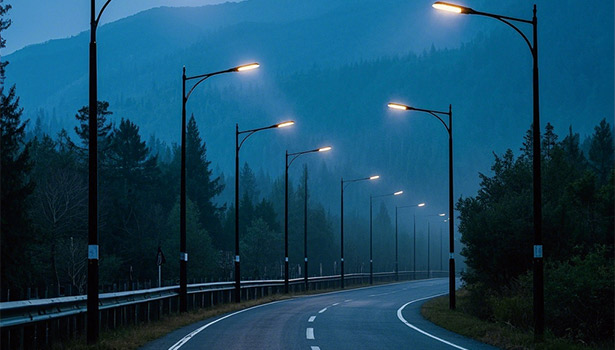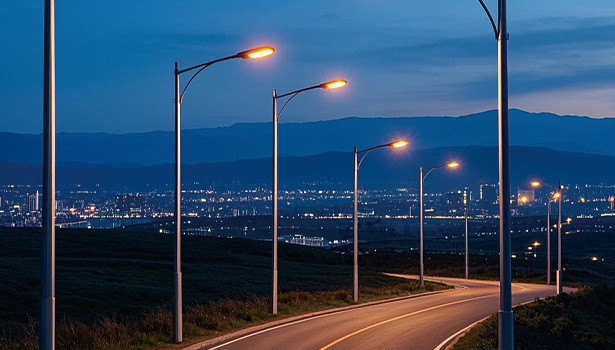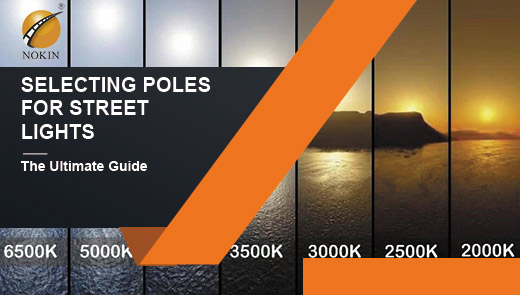5 Tips For Choosing Solar Street Light Poles
Under the global trend of advocating energy saving and emission reduction, solar energy, as a kind of clean and renewable energy, is more and more widely used in various fields. In the outdoor lighting segment, solar street lights have become the main force in lighting up urban and rural roads with their significant energy-saving advantages and environmental protection features. However, to give full play to the efficacy of solar street lights, not only depends on the quality of solar panels and lights, the appropriate street lamp pole also plays a decisive role. If the street light pole is not selected properly, it will not only affect the lighting effect, but also may lead to safety hazards and increase the maintenance cost. Next, here will provide you with a detailed introduction to the selection of solar street light pole 5 practical points, to help you create efficient and durable solar street light lighting system.

Determine the right height for solar street light poles
When determining the optimal height of solar street light poles, it is necessary to comprehensively consider the street width, pole spacing, climate conditions and lighting needs and other factors, in order to achieve the lighting effect and optimize the use of resources.
Consideration of street width
The wider the road, the higher the height of the required street light pole. There is a scientific optical principle behind this, the higher the pole can make the light to a wider angle scattering, illuminating a wider area, to ensure that the whole road can get enough lighting. Generally speaking, depending on the width of the road, the height of street light poles ranges from 3 to 15 meters. For narrow alleys, a 3 - 5 meter high pole may be sufficient to meet the lighting needs, while on major city roads, a pole height of 10 - 15 meters is often required to illuminate multiple lanes of traffic in both directions.
Pole spacing
Ideally, the spacing between poles should be maintained at about 30 meters, which ensures that there is sufficient illumination throughout the road to avoid dead spots. However, the actual spacing will vary depending on the shape of the road, the number of bends and the traffic flow. On straight roads, a 30-meter spacing is more appropriate; but on roads with more curves, in order to ensure that drivers can see the road ahead of time, the spacing of light poles may need to be appropriately reduced. In addition, on roads with high traffic flow, the light poles may need to be spaced more closely to ensure traffic safety.
Lighting requirements
If the road is mainly used for vehicular traffic, lower intensity lighting can meet the demand. As the vehicles are equipped with their own lighting equipment, only street lights are required to provide supplementary lighting. However, if there are more pedestrians or cyclists on the road, in order to ensure their safety, a higher intensity of lighting is required, and higher light poles may be needed to achieve the required lighting intensity. For example, on roads near schools and parks, where there is a high volume of pedestrian traffic and people move relatively slowly, bright lighting is needed to reduce the likelihood of accidents.
Climatic conditions
Local climatic conditions, such as wind and snowfall, are also factors that should not be ignored. In windy areas, it is advisable to use higher light poles to avoid the light being blocked by surrounding buildings or trees. Strong winds may cause tree branches to sway and block the light from lower light poles, which a taller pole can effectively minimize. Similarly, in areas with heavy snowfall, light poles must be high enough to prevent snow from covering the fixtures. Not only will snow affect the lighting, but the weight may also cause damage to the pole.

Choose the right material for solar street light poles
The material of the street light pole is directly related to its durability and resistance to environmental erosion. Outdoor environments are complex and changeable, and street light poles are subjected to wind, rain, sun, cold, heat and other natural factors all year round, and may also be subjected to human damage. The ideal material should be durable, weather-resistant and able to withstand environmental factors such as wind, rain and corrosion. Only by choosing the right material can we ensure that the street light poles remain stable during long-term use and reduce maintenance and replacement costs.
Galvanized steel
Galvanized steel is a popular choice due to its excellent durability and corrosion resistance. The galvanized layer effectively prevents steel from rusting, making it especially suitable for outdoor environments. A layer of zinc on the surface of the steel is like a strong armor for the steel, preventing oxygen and moisture from coming into contact with the steel, thus slowing down the corrosion process. In addition, the steel pole is strong enough to support the weight of the solar panels and lights. The steel commonly used for solar street light poles is Q235, which combines corrosion resistance, service life, ease of transportation and price, making it extremely cost-effective. Its moderate strength makes it easy to process and manufacture, which ensures the quality of the street light poles and reduces the production cost at the same time.
Aluminum
Aluminum is another commonly used material that is not only lightweight but also has good corrosion resistance. Aluminum will react with oxygen in the air to form a dense protective film of aluminum oxide, which effectively prevents further corrosion of aluminum. Although aluminum is not as strong as steel, its light weight reduces installation and transportation costs. In some remote areas or inconvenient places, the use of aluminum street light poles can greatly reduce the difficulty of transportation and installation. In addition, the appearance of aluminum street light poles is more beautiful, with a certain degree of decorative.
Stainless steel
Stainless steel street light poles are extremely durable, with excellent resistance to rust, corrosion and dirt. It is particularly suitable for harsh environments such as coastal or industrial areas, which are often exposed to seawater and pollutants. In coastal areas, the sea breeze contains a large amount of salt, which is highly corrosive to metal materials, and stainless steel street light poles can effectively resist this corrosion. In addition, stainless steel street light poles have a beautiful appearance and a long service life, and their smooth surface is not only easy to clean, but also enhances the overall aesthetics of the road.
Fiberglass
Fiberglass street light poles are increasingly used in windy or extreme weather areas. Fiberglass is light, strong, corrosion-resistant and non-conductive, making it safer to use in areas where electrical hazards exist. In Europe and the United States, for example, the use of fiberglass light poles have 50 years of experience, the strength of the material applied to the pole, but also effectively reduce the chance of lightning strikes, to protect the safety of personnel. The manufacturing process of fiberglass light poles is relatively flexible and can be customized according to different needs to meet the lighting requirements of various special scenes.
Hot-dip galvanization Or cold galvanization
Processing differences
Cold galvanizing: Cold galvanizing, also known as electro-galvanizing, is to put the light pole blanks treated with degreasing and pickling into the zinc salt solution, connect the negative pole of the electrolysis equipment, place the zinc plate on the opposite side of the work piece and connect the positive pole of the electrolysis equipment, and then deposit a layer of zinc on the surface of the work piece by using the directional movement of electric current from the positive pole to the negative pole after the electricity is energized. The advantages of this process are simple operation, relatively low cost, and the ability to uniformly coat the surface of work pieces with complex shapes with a zinc layer. However, due to the thinness of the cold galvanized layer, its protective properties are relatively weak.

Hot-dip galvanizing: Hot-dip galvanizing, on the other hand, involves degreasing, pickling, dipping, and drying the light pole blanks, then immersing them in a molten zinc solution for a period of time and removing them. The Energy Conservation Technical Specification for Hot-Dip Galvanizing Hot Work Systems for Steel Pipes, which came into effect on April 1, 2025, clearly specifies the process and energy conservation targets for hot-dip galvanizing. The hot-dip galvanizing process enables the zinc layer to form an alloy layer with the steel surface, which greatly improves the adhesion and corrosion resistance of the zinc layer. The thickness of the hot-dip galvanized layer is usually much thicker than the cold galvanized layer, and the protective effect is more durable.
Appearance differences
Cold galvanized rods are smoother and brighter in appearance. After the color passivation process, the plating layer is mainly yellowish-green and colorful; the plating layer treated with white passivation process shows greenish-white or white with greenish light, and slightly colorful luster at a specific angle. In the corner parts of complex work pieces, due to uneven current distribution, it is easy to produce “electric burning” phenomenon, resulting in the part of the gray color, and the zinc layer is thicker. In the corner parts, it will form a current dead zone, resulting in undercurrent gray area, the region of the zinc layer is thinner. Overall, cold galvanized work pieces do not have zinc tumors or lumps.
Hot-dip galvanized rods have a slightly rougher appearance compared to cold-dip galvanized rods, with a silvery-white color. Its surface is prone to process water lines and a few drip tumors, especially at one end of the work piece, this phenomenon is more obvious. However, this appearance of hot-dip galvanized rods does not affect their performance, but rather reflects their unique manufacturing process.

Corrosion resistance and cost
The thickness of the hot-dip galvanized layer is tens of times thicker than the cold galvanized layer, and its corrosion resistance is tens of times higher than that of cold galvanizing. The thicker coating of hot-dip galvanizing provides longer-lasting protection for steel and reduces damage caused by corrosion. Because of this, hot-dip galvanized products are much more expensive than cold galvanized. However, in terms of long-term cost, the high corrosion resistance of hot-dip galvanized street light poles reduces the number of maintenance and replacements, and the overall cost may be lower.
Choose the right wall thickness for solar street light poles
The wall thickness of a street light pole directly affects its wind resistance and load-bearing capacity, which in turn relate to the service life of the solar street light. Reasonable wall thickness design can ensure the stability and structural strength of the pole, preventing safety accidents such as tipping and breaking caused by insufficient thickness. In strong winds, the light pole needs to withstand huge wind force, if the wall thickness is insufficient, the light pole may be blown over, posing a serious threat to pedestrians and vehicles. In addition, the wall thickness also affects the carrying capacity of the pole for solar panels and lights to ensure that they can be stably installed.
Wall thickness reference standard
The wall thickness requirement varies for different materials of street light poles:
|
Lamp Post Material |
Wall Thickness Requirement |
|
Steel Lamp Post |
Should be no less than 3mm. For lamp posts of 4-9 meters, the wall thickness should be at least 4mm; for 12-meter and 16-meter lamp posts, the wall thickness should be at least 6mm. |
|
Stainless Steel Lamp Post |
Should be no less than 2.5mm. |
|
Aluminum Alloy Lamp Post |
Should be no less than 4mm. |
These standards are based on the mechanical properties of different materials and actual usage requirements. In windy areas, the wall thickness should be increased appropriately to meet higher wind resistance requirements. For example, in coastal areas, which are often affected by typhoons, the wall thickness of street light poles needs to be thicker than in ordinary areas to ensure the safety of the poles.
Choose the right diameter of solar street light poles
When choosing the diameter of the street light pole, too big or too small is not suitable. Light poles with too small a diameter are easily blown over in strong winds because they have a small wind-resistant area and cannot withstand large wind forces. And the diameter of too large a light pole is not only difficult to install, may require heavy equipment such as cranes, and more costly. In addition, too large a diameter will also affect the aesthetics of the street light pole, and the surrounding environment is not coordinated. Therefore, choosing the right diameter is critical to both the performance and cost control of the street light pole.
Common pole types
The solar street light poles widely used in the market are mainly conical and octagonal. Conical street light poles are made of steel plate rolled by machine, with common taper of 10‰, 11‰, 12‰, 13‰ and 14‰, and the minimum upper diameter of the pole is φ60mm. This conical design is not only beautiful, but also conforms to the principle of mechanics, which can better withstand the wind and the weight of the lights and lanterns. Octagonal street light poles have better stability and are often used in occasions with high stability requirements.
Tapered light pole size and taper calculation
Upper Diameter + (Height × Taper) = Lower Diameter
Lower Diameter - (Height × Taper) = Upper Diameter
(Lower Diameter - Upper Diameter) ÷ Height = Taper
(Lower Diameter - Upper Diameter) ÷ Taper = Height
An example of a 20-foot street light pole would have a typical bottom diameter of 130 - 140mm (5.2 - 5.6 inches) and a top diameter of 60 - 76mm (2.5 - 3 inches). These formulas allow you to accurately calculate the dimensions of a tapered street light pole based on actual needs, ensuring that the pole is designed to meet the requirements.
Choosing a solar street light pole is a systematic project, which requires comprehensive consideration of many factors such as height, material, galvanizing process, wall thickness and diameter. Only by comprehensively considering these points and fully combining the actual use of the scene and demand, can we select the solar street light pole with excellent performance and long service life. The right street light pole not only ensures that the solar street light plays the best lighting effect, but also reduces the maintenance cost, extends the service life, and contributes to the cause of energy saving and emission reduction. In the future field of outdoor lighting, with the continuous progress of technology and the increasing improvement of standards, the selection of solar street light poles will have a more scientific and standardized method to promote the sustainable and healthy development of the solar street light industry.




